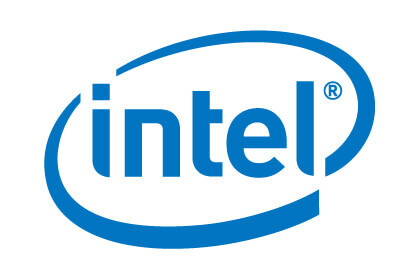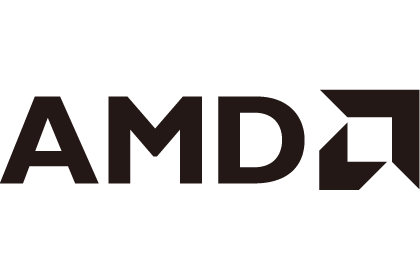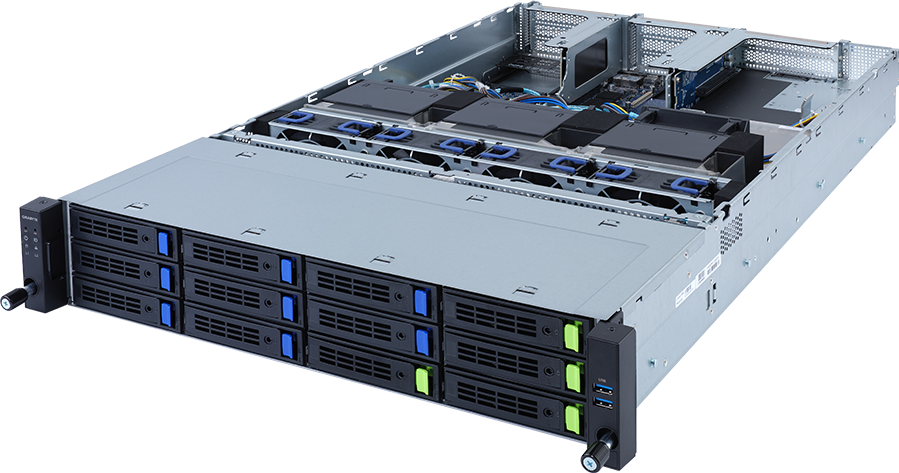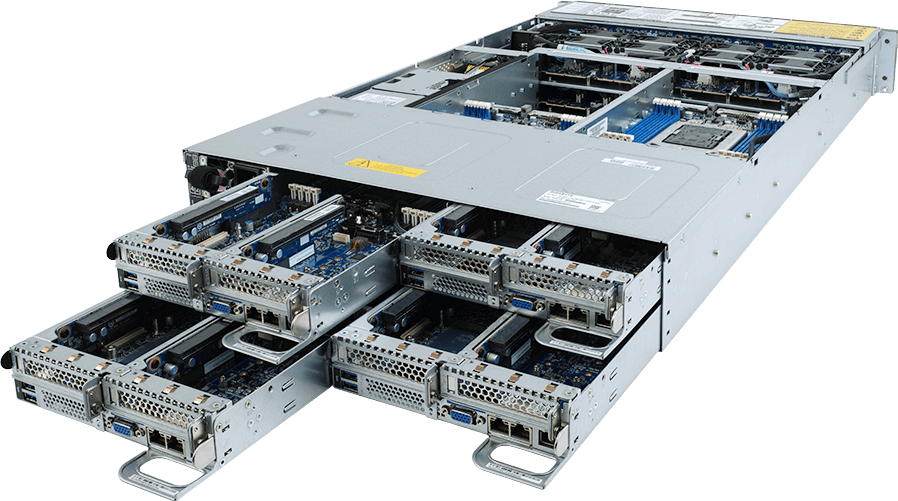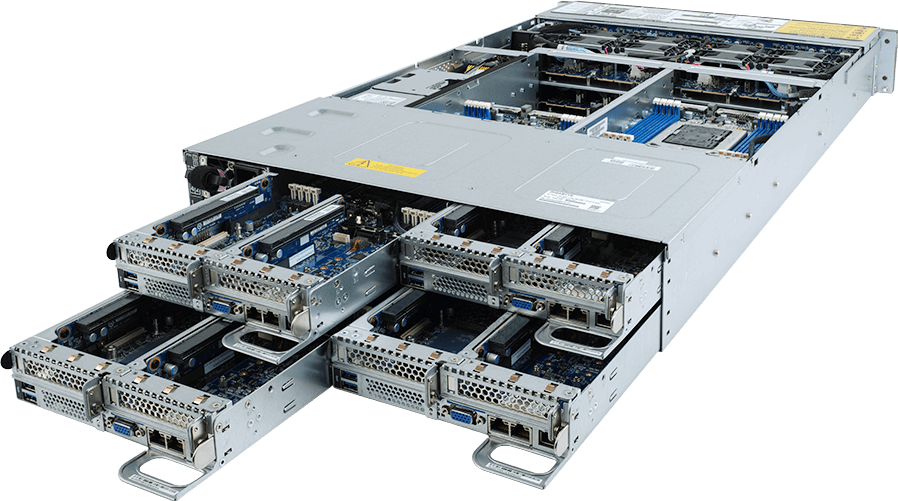Introduction
GIGABYTE now offers solutions for Microsoft Azure Stack HCI, designed for customers who want to run their virtualized applications on premises while updating and consolidating their aging server infrastructure, and giving them the benefits of integration with Microsoft Azure for cloud based backup, monitoring and site recovery. GIGABYTE’s solutions offer industry leading performance, density and configuration flexibility, and has been validated for Microsoft’s Azure Stack HCI program while offering ease of deployment and management.
When to Use Azure Stack HCI?
The Challenges of Deploying On-Premises HCI
While migrating your IT workloads to the cloud yields excellent benefits and efficiencies such as simpler maintenance and improved scalability, many businesses still need to run many virtualized applications on-premises in their own datacenter environments. Sometimes it’s not an option to migrate these applications to the cloud, or it’s still cheaper to run them on premises.
To support these on-premises workloads customers have increasingly been embracing Hyper Converged Infrastructure (HCI) as the preferred way to lower costs, improve performance and availability, and simplify operations. The problem however, is that few HCI solutions offer a path toward cloud integration - HCI and cloud, after all, aren’t mutually exclusive goals.
Many businesses hope to gradually progress toward a hybrid cloud model, in which smoothly interoperating resources, managed together, are located both on premises and in the cloud. And these customers, above all, need an HCI solution that can offer a simple, optional on-ramp to cloud services while still delivering the improved efficiencies that are driving the fast adoption of HCI.
Is there a smooth and inexpensive way for customers to refresh their aging and expensive hardware for their on-premises virtualized applications, and also gain the benefits of hybrid cloud integration?
Microsoft Azure Stack HCI Benefits
Hardware Consolidation
Top Tier Performance
High Availability
Enhanced Security
Integration with Azure Cloud
The Solution: Microsoft Azure Stack HCI
Microsoft Azure Stack HCI is an on-premises, hyper converged infrastructure solution based on Windows Server 2019, bringing together software defined compute, storage and networking on pre-validated, industry-standard servers and components. It’s a great solution for customers who want to refresh aging server and storage infrastructure, consolidate virtualized workloads and gain cloud efficiencies on-premises while easily extending to Microsoft Azure for hybrid cloud services. The goal is to meet customer workloads and help them solve their current needs, while giving them room to grow and evolve as business and IT needs change.
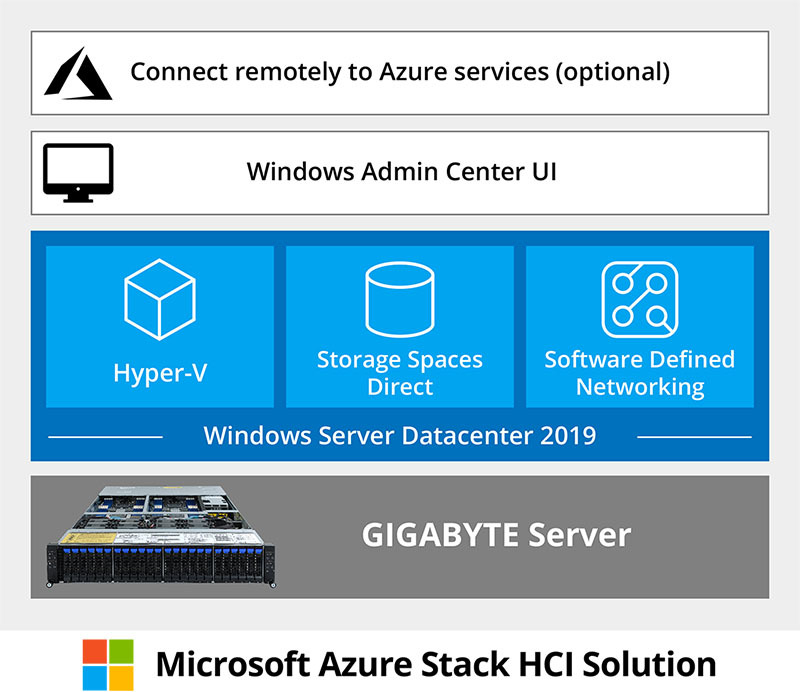
Microsoft Azure stack HCI Solution
An Azure Stack HCI solution consists of technologies you are already familiar with in Windows Server: Hyper-V for software defined compute, Storage Spaces Direct for software defined storage, and software defined networking. They are combined with a unified HCI management experience through Windows Admin Center, and all of these technologies are running on a pre-validated hardware solution from partners such as GIGABYTE. The customer can also easily connect to Microsoft Azure for hybrid services such as cloud-based back-up, site recovery and more. Take all of these pieces together, and you have an Azure Stack HCI Solution.
Why Use Azure Stack HCI?
・Hardware Consolidation:
Consolidate traditional virtual apps that must remain on-premises with software-defined compute, storage, and networking on GIGABYTE’s high-density multi-node servers providing industry leading density and performance.
・Top Tier Performance:
・Top Tier Performance:
Achieve top tier virtual machine performance with Hyper-V and Storage Spaces Direct technology with built-in support for non-volatile memory express (NVMe) and remote direct memory access (RDMA) networking.
・High Availability:
・High Availability:
Achieve comprehensive redundancy with built-in clustering and distributed software resiliency.
・Enhanced Security:
・Enhanced Security:
Help keep apps and data secure with shielded virtual machines, network micro-segmentation, and native encryption for data at rest and in transit. Minimize the impact of malware by isolating different workloads in separate VMs with secure virtualization fabric.
・Integration with Azure Cloud:
・Integration with Azure Cloud:
Quickly and easily extend to Microsoft Azure for hybrid cloud integration, with simplified access to cloud management and security services for offsite backup, site recovery and file synchronization.
・Powerful Management:
・Powerful Management:
Manage with your choice of command-line automation or use Windows Admin Center, a single browser-based HCI remote management interface that includes software-defined configuration and monitoring of workloads running on-premises and in Azure.
More Use-Case Scenarios for Azure Stack HCI
Consolidate Data Centers
Customers using Azure Stack HCI can quickly and easily extend their on-premises virtualized applications to Microsoft Azure with simplified access to the cloud management and security services. For example, with Azure Site Recovery, instead of having an extra data center somewhere across town or in a different region, they can use Azure for site recovery and failover for their on-premises workloads.
Customers using Azure Stack HCI can quickly and easily extend their on-premises virtualized applications to Microsoft Azure with simplified access to the cloud management and security services. For example, with Azure Site Recovery, instead of having an extra data center somewhere across town or in a different region, they can use Azure for site recovery and failover for their on-premises workloads.
Virtualize Microsoft SQL Server
Deploy and manage high-performance, scalable SQL Server running on hyper converged infrastructure. Run your applications with high availability and the flexibility of virtualization while using Azure Backup and Azure Blob Storage to back up and restore your organization’s data.
Deploy and manage high-performance, scalable SQL Server running on hyper converged infrastructure. Run your applications with high availability and the flexibility of virtualization while using Azure Backup and Azure Blob Storage to back up and restore your organization’s data.
Apply Trusted Enterprise Virtualization
Use virtualization-based security and certified hardware to help protect your security-sensitive workloads. Connecting this trusted infrastructure to Azure Security Center activates behavioral analytics and reporting to account for rapidly changing workloads and threats.
Scale-Out Storage
Combine unmatched storage and performance with validated hardware to centralize your organization's file shares. The Azure file sync feature keeps the flexibility, performance, and compatibility of an on-premises file server while replacing an aging storage area network or aggregating files from multiple sources.
General-Purpose Kubernetes
Enable automated deployment, scaling and management of containerized applications by running a Kubernetes cluster on your hyper converged infrastructure. Utilize Azure Monitor for containers to deliver a comprehensive monitoring experience to understand the performance and health of your clusters, from infrastructure to application.
The Best Choice for Azure Stack HCI: GIGABYTE Server Hardware
GIGABYTE has worked closely together with Microsoft to validate a selection of our High Density 2U 4 Node systems for Azure Stack HCI, guaranteed to provide optimal performance and reliability and supporting the latest technologies such as NVMe storage and RDMA networking.
Why Choose GIGABYTE for Azure Stack HCI?
Maximum Hardware Consolidation
GIGABYTE’s High Density Series systems offer market leading compute density. One single 2U 4 node rack server can support up 128 CPU cores per half-width node and 512 cores per 2U system*, so your virtualized applications that previously required an entire rack of legacy servers can now be consolidated into a single 2U system, greatly reducing power consumption and space requirements.
*Using GIGABYTE’s H262-Z61 with AMD EPYC 7742 CPU
Multi-Node Architecture for Lower TCO
GIGABYTE’s High Density Series systems feature four half-width compute nodes in a 2U chassis. All nodes share the same cooling fans and redundant power supplies, to help reduce energy consumption and maintenance burden. This allows our 2U 4 node system to “…deliver virtually identical performance to four 1U servers while reducing rack space by 50%, power consumption by 4% and the number of power supplies by 75%”*
GIGABYTE’s High Density Series systems offer market leading compute density. One single 2U 4 node rack server can support up 128 CPU cores per half-width node and 512 cores per 2U system*, so your virtualized applications that previously required an entire rack of legacy servers can now be consolidated into a single 2U system, greatly reducing power consumption and space requirements.
*Using GIGABYTE’s H262-Z61 with AMD EPYC 7742 CPU
Multi-Node Architecture for Lower TCO
GIGABYTE’s High Density Series systems feature four half-width compute nodes in a 2U chassis. All nodes share the same cooling fans and redundant power supplies, to help reduce energy consumption and maintenance burden. This allows our 2U 4 node system to “…deliver virtually identical performance to four 1U servers while reducing rack space by 50%, power consumption by 4% and the number of power supplies by 75%”*



